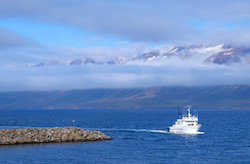International prize for safety at sea goes to system developed by EU-funded project
In the first project of its kind, SEAHORSE, which is led by the University of Strathclyde, brought together industry experts to research and implement the safety procedures used by the aviation industry and apply them to the maritime sector. The consortium is headed by Professor Osman Turan from the University of Strathclyde’s Department of Naval Architecture, Ocean and Marine Engineering, and also includes Scottish ferry operator Caledonian MacBrayne (CalMac) along with industry leaders from across the world. Now the Institute of Naval Architects, in association with Lloyd’s Register, has recognised their work by awarding the team with the highly prestigious Maritime Safety Award. Applying aviation safety standards to the maritime sector The aviation industry has rigorous safety standards to which it has to adhere. Aiming to influence best practice throughout commercial shipping, the project set out to develop and implement systems such as checklists and safety reporting as part of standardised set of operating procedures. SEAHORSE, which received EU funding until 2016, worked on the premise that while many companies had such steps in place, what they were checking varied widely and many of their safety tools had evolved to become cumbersome. A straightforward, standardised approach would be both simpler to put in place and more effective. Uptake by industry leaders CalMac, the ferry operator whose network of routes links the many islands off the Scottish coast, was one of the checklist’s pioneers. CalMac collaborated closely with Airbus who advised them when it came to drawing up and trialing their new system across 10 of the company’s roll-on, roll-off ferries. Input from the masters fine-tuned the system as it was developed to reduce how long the procedure took while ensuring nothing important was left out. As with an airline checklist, the system involves a check command and verification response thereby ensuring two people ratify each step. A significant weakness of various checking procedures in the past has been what is known as a ‘single point of failure’ which can arise if only one person in involved. This was mitigated and reduced by the pair-checking routine. CalMac’s trial will form the basis for uptake by different types of commercial shipping: they may not all apply the same items for checking, but the system is now a tried and tested framework that is easily transferrable. CalMac itself is now a confirmed adopter. The team at Strathclyde believe the project shows that methods used to ensure high levels of safety in one transport sector can be transferrable to others and they hope that their breakthrough will lead to stronger cooperation between different transport modes. For more information, please see: project website
Countries
United Kingdom



